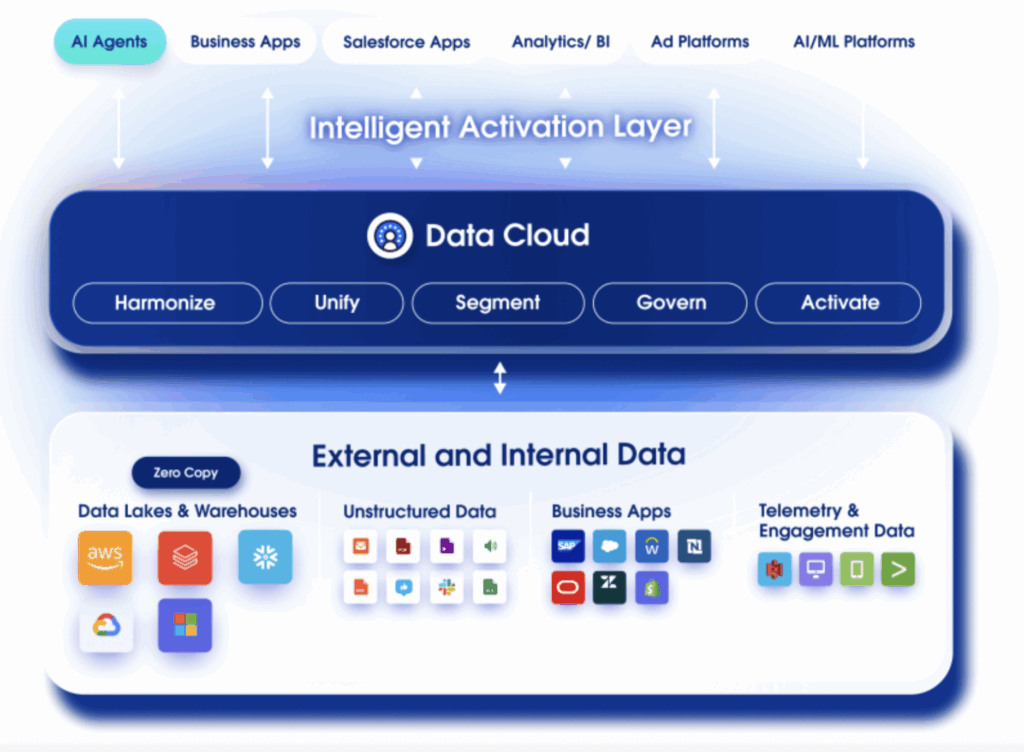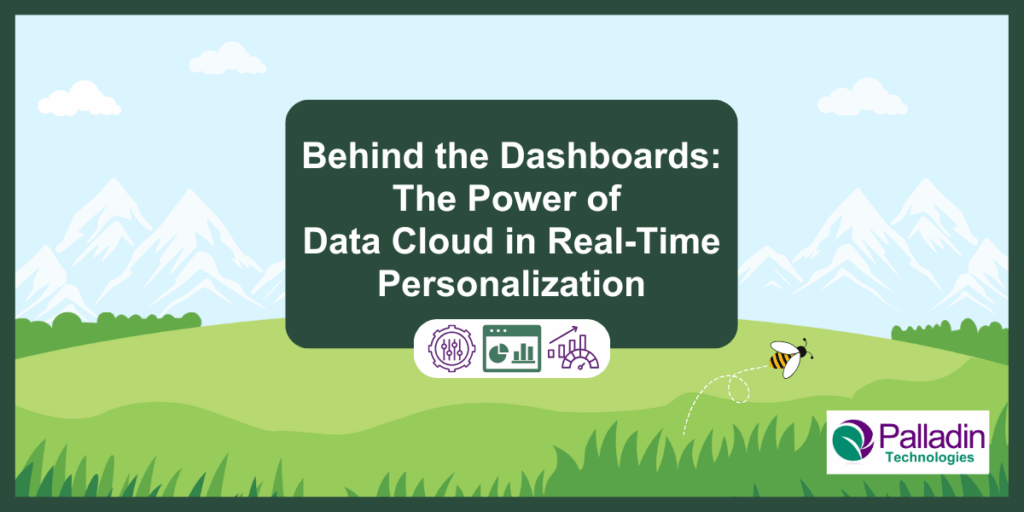In today’s digital-first world, customer expectations are higher than ever. They demand personalized experiences — not just tailored emails or ads, but real-time, context-aware interactions across every touchpoint. Whether it’s recommending the right product at the right moment or routing a service case based on recent behavior, companies are racing to deliver seamless experiences that feel intuitive and human.
The challenge? Personalization at scale requires more than just data — it requires connected, real-time data that flows across systems, channels, and teams. Traditional architectures, often siloed and batch-processed, can’t keep up.
That’s where Salesforce Data Cloud comes in.
Acting as the connective tissue between raw data, artificial intelligence, and advanced analytics, Data Cloud enables businesses to unify information, create dynamic customer profiles, and make split-second decisions. Paired with platforms like CRM Analytics, Tableau, and the next-generation Tableau Next, it unlocks a new level of insight, usability, and actionability.
1. The Engine Behind Personalization: What is Salesforce Data Cloud?
Salesforce Data Cloud is the real-time data engine at the heart of Salesforce’s AI and analytics strategy. It ingests customer data from across the business — CRM systems, websites, marketing platforms, and external sources — and transforms it into a harmonized, dynamic customer profile.

What sets Data Cloud apart in the analytics stack isn’t just its unification capabilities, but its ability to deliver live, contextual data into the decision layer — where dashboards, predictive models, and AI agents operate.
Key Features of Salesforce Data Cloud:
| Feature | Description |
| Real-Time Ingestion | Data streams continuously, keeping dashboards and KPIs current. |
| Identity Resolution | Customer records are deduplicated and connected across platforms. |
| Calculated Insights & Segments | Metrics like churn risk or engagement scores are defined once and used across tools for consistency. |
| Activation Across Tools | Insights can be pushed into Tableau, CRMA, or used to trigger workflows. |
This same intelligence also powers Salesforce AI agents like Einstein Copilot, helping sales and service users take informed actions based on real-time insights.
In short, Data Cloud doesn’t replace your analytics tools — it makes them more innovative, faster, reliable, and deeply integrated.
2. Unified Data in Action: How Data Cloud Enhances Analytical Strategy
The biggest barrier to good analytics isn’t the lack of tools — it’s the fragmented, outdated data feeding them.
Today’s data often lives across CRMs, marketing platforms, service systems, spreadsheets, and third-party apps. Just bringing it together takes weeks of manual ETL, schema alignment, and deduplication. By the time a dashboard is ready, the data is already stale.
Salesforce Data Cloud solves this by acting as a live, scalable data layer that sits across Salesforce and non-Salesforce systems. Built natively on the Salesforce platform, it reduces integration friction, accelerates time to value, and delivers a real-time view of your business.
Key capabilities of Data Cloud:
| Capability | Value |
| Unified Data Model | Built-in understanding of Salesforce objects and metadata. |
| 360° Profiles | Holistic customer/account views that reflect transactions, behaviors, and intent. |
| Live Analytics Feeds | Seamless integration with CRM Analytics, Tableau, and Tableau Pulse. |
| Cross-Team Consistency | Shared logic for segmentation and KPIs across departments. |
| Analytics Activation | Real-time insights trigger workflows, alerts, and operational responses. |
With Data Cloud, analytics becomes a core, proactive driver of strategy — not a passive reporting layer.
3. The Power Combo: CRM Analytics + Data Cloud
CRM Analytics (CRMA) is designed to bring insights directly into the flow of work inside Salesforce — from Sales Cloud to Service Cloud and beyond. With Data Cloud as its backend, CRMA delivers more context, speed, and personalization to frontline users.
| Insight Capability | Description |
| Behavioral Analytics | Analyze real-time behavior alongside Salesforce records. |
| Segmented Dashboards | Filter views using Data Cloud-defined segments like churn risk or LTV. |
| Predictive Modeling | Use Einstein Discovery on enriched profiles for forecasts and recommendations. |
| In-Context Insights | Embed analytics directly into Salesforce record pages. |
CRMA’s ability to reuse Data Cloud logic — like shared metrics or segments — ensures that business logic is applied consistently, without duplication.
With CRMA + Data Cloud, Salesforce evolves from a system of record to a system of real-time insight and action.
4. Simplifying the Data Layer: Tableau + Data Cloud
Tableau remains a go-to platform for enterprise BI teams that need deep data exploration and cross-functional dashboards. While it offers broad connectivity to databases and cloud systems, that flexibility can become a challenge when data is fragmented and inconsistent.
Salesforce Data Cloud streamlines this by acting as a unified, analytics-ready layer that Tableau can query directly — reducing technical debt and accelerating time to insight.
Tableau Improvements with Data Cloud
| Benefit | How It Helps |
| ETL Simplification | No need to manually join disparate data — Data Cloud handles it upstream. |
| Faster Dashboard Builds | Analysts work with trusted, curated data from the start. |
| Governance and Trust | Shared metrics reduce inconsistencies across teams. |
| Scalable Architecture | Fewer direct connectors = better performance and maintainability. |
For organizations already invested in Tableau, Data Cloud becomes the ideal staging layer — combining flexibility with data alignment and trust.
5. Real-Time Analytics with Tableau Next
Tableau Next is Salesforce’s vision for the next generation of analytics: an AI-native platform designed to work natively with Data Cloud and redefine how business users interact with data.
Rather than requiring dashboards to be manually built and maintained, Tableau Next introduces agentic analytics — where AI agents help define metrics, surface anomalies, and even suggest actions in real time.
What Makes Tableau Next Different:
| Feature | What It Delivers |
| Built on Data Cloud | Native access to real-time, unified data — no data prep or manual extraction. |
| AI + Semantic Layer | Users ask business questions in plain English; AI translates them into analytics. |
| Insight to Action | Instantly trigger workflows or follow-up actions based on insights. |
| Slack Integration | Push alerts, summaries, or visuals directly into Slack for faster collaboration. |
With Tableau Next, analytics shifts from being reactive to proactive and collaborative — always available, always contextual, and always actionable.
6. The Future of Data-Driven Decisions
The future of business isn’t just about being data-driven — it’s about being data-responsive.
As real-time expectations rise and AI becomes central to every function, the ability to make smart decisions in the moment is what separates leaders from laggards.
Salesforce Data Cloud is the foundation of this transformation — enabling unified data, powering intelligent analytics, and delivering personalized, automated insights through tools like CRMA, Tableau, and Tableau Next.
This future isn’t abstract — it’s being built right now.
As a certified Salesforce partner, our team helps organizations activate the full power of Salesforce Data Cloud — from architecture to analytics, from insight to execution.
What the Future Looks Like
| Then (Traditional BI) | Now (With Data Cloud & AI) |
| Static dashboards | Real-time insights |
| Disconnected data sources | Unified customer profiles |
| Delayed reporting | Instant alerts and predictive recommendations |
| Manual actions | Automated workflows and AI-assisted decision-making |
We’re here to help you move from disconnected data to coordinated decisions.
Contact us today to learn how we can bring your analytics strategy to life with Salesforce Data Cloud.
Learn More About Partnering With Us!
Data Analyst
Matheus Barbosa is a Data Analyst specializing in CRM Analytics and Tableau. With expertise in Business Intelligence and data visualization, he builds dynamic dashboards, optimizes ETL processes, and transforms complex data into actionable insights. He has hands-on experience with Salesforce Sales, Service, and Core Cloud, leveraging CRM Analytics, Tableau, Tableau Prep, Recipes, and Dataflows to deliver impactful solutions. Skilled in SAQL, JSON, SOQL, SQL, and VizQL, Matheus combines functional and programmatic development to support consulting projects across industries. Before joining Palladin, he held roles at NTT DATA, GFT Technologies, and Capgemini, honing his skills in CRM Analytics, Einstein Analytics, and Agile delivery.

